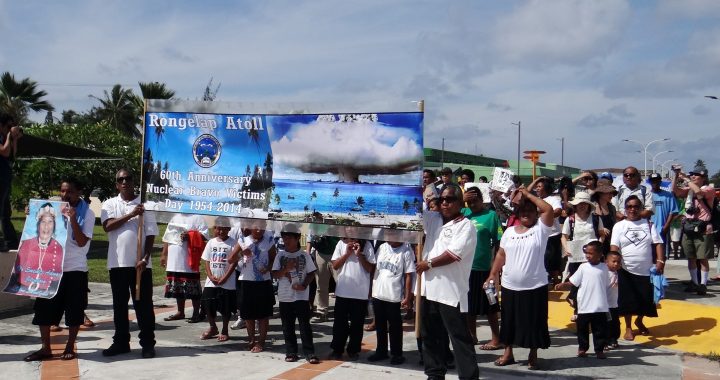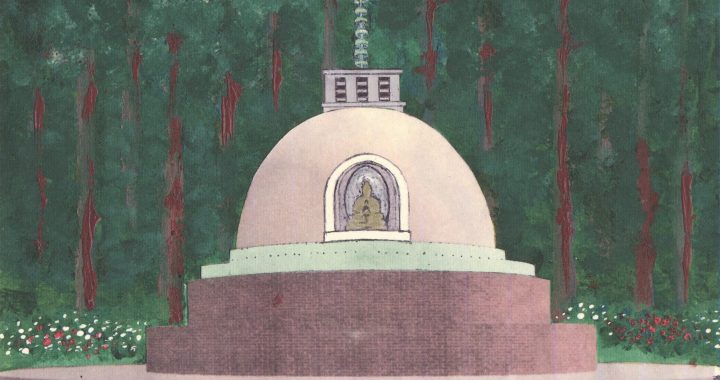By Leonard Eiger
March 1, 2023
March 1st is Nuclear Free and Independent Pacific Day (‘Bikini’ Day) which marks the anniversary of the infamous US ‘Bravo’ nuclear bomb detonation at Bikini Atoll in 1954.
On that fateful day the United States tested the first deliverable hydrogen bomb, code named “Bravo”, at Bikini Atoll, in the Marshall Islands. Bravo was the largest U.S. nuclear test ever exploded, with a yield of 15 megatons, 1000 times larger than the bomb dropped on Hiroshima (and well beyond the predicted yield of 6 megatons… OOOPS!). It blasted a crater 1.2 miles in diameter into the atoll. Not to be outdone, the Soviet Union detonated the 58 megaton Tsar Bombathermonuclear bomb over Severny Island, Novaya Zemlya on October 30, 1961.
Castle Bravo was supposed to be a secret test, but because its designers underestimated its yield, things went dreadfully wrong in a flash. Because of the fission products, huge yield and shifting winds, radioactive fallout from the cloud spread quickly and far, contaminating over seven thousand square miles of surrounding ocean and nearby inhabited islands including Rongerik and Rongelap. The flash could be clearly seen 250 miles away (some secret!).
Radioactive fallout from the test affected U.S. service personnel on ships, natives of Rongelap Island, 100 miles from the test, Utrick Island, 300 miles away, and fishermen on a Japanese vessel, the Daigo Fukuryu Maru, or Lucky Dragon. The crew were fishing outside of the U.S. declared exclusion zone when Castle Bravo detonated. The ship was covered in fine radioactive ash soon after the explosion. By the time the ship returned to Japan all 23 crew members suffered from the effects of acute radiation syndrome – including nausea, headache, burns, pains in the eyes, and bleeding from the gums – and were admitted to hospitals.
One of the crew, chief radio operator Aikichi Kuboyama, died on September 23 from the effects of radiation exposure. His last words were:
“I pray that I am the last victim of an atomic or hydrogen bomb.”
Several hundred other fishing vessels and their crews were also exposed to the fallout from Castle Bravo.
The nearby islands’ inhabitants as well as U.S. military personnel stationed there for the test were exposed to the radioactive fallout, and subsequently evacuated. All were exposed to significant levels
of radiation; although short term effects were mild, long term effects were significant for many. 90% of the Marshall Islands’ population experienced thyroid tumors. The Marshall Islanders and their lands were essentially involuntary test subjects in the U.S. governments nuclear testing, as were U.S. service personnel.
The U.S. continued atmospheric nuclear testing around the Marshall Islands, conducting 67 tests at Bikini and Enewetak atolls between 1946 and 1958 leaving a legacy of contamination and death. A study in the late 1990s published in the journal of the American Cancer Society found that cancer rates in the Marshall Islands were “alarming,” and the author of the study stated “that the incidence if cancer in the Marshall Islands was ‘extreme.’”
In 1956, the United States Atomic Energy Commission called the Marshall Islands “by far the most contaminated place in the world.” Today – 69 years later – the Marshall Islands are still contaminated, and radioactive cesium is found in water and fruits.
Back in the early 1970s the U.S. government declared Bikini safe for resettlement, and some residents returned. They were removed once again in 1978 after it was discovered that they had ingested high levels of radioisotopes from eating foods grown on the former nuclear test site. Residents of Rongelap Atoll underwent similar indignities. The U.S. has been derelict in failing to protect the health and welfare of the Marshall Islanders and their lands, and has failed to recognize their suffering and adequately compensate them.
This Nuclear Remembrance Day is an opportune moment to consider the legacy of our nation’s embrace of the failed doctrine of Strategic Nuclear Deterrence, and more importantly, the critical juncture we have reached 69 years after the Bravo test and the opportunities presented to us.
The Cold War ended just over 31 years ago; and yet the United States and Russia still maintain thousands of nuclear missiles ready to launch on warning, more than enough thermonuclear firepower to end civilization as we know it, and possibly all life on this planet. The President of the United States may have just a few minutes to make the fateful decision to launch nuclear weapons in case of warning of a nuclear attack. In 1995, in one of the most well-known incidents, Russia came within a few minutes of launching a nuclear counterattack after it initially interpreted the launch of a scientific rocket from Norway as a first strike. And now, tensions between the US and Russia are at the highest level since the Cuban Missile Crisis. Humanity stands at the brink of the unthinkable.
Administration after administration (in the US) has repeatedly refused to adopt a “No First Use” policy, including the Biden administration. For all the talk of other nuclear nations (including Russia) building up their nuclear forces, the US has led the way – research on a new fleet of ballistic missile submarines (currently in production) began in 2007, and there is a new warhead planned, a new generation of ICBMs, modernization of the infrastructure that designs, builds and maintains our nation’s nuclear weapon systems, and more.
The latest (2022) US Nuclear Posture Review is evidence that, regardless of the rhetoric of any recent president about a “commitment to seek the peace and security of a world without nuclear weapons,” powerful forces in the Pentagon and weapons industry, along with their nearly unanimous Congressional support team make sure that nuclear weapons programs come first (and are fully funded)! The NPR makes it clear that nuclear weapons will continue to play a central role in US foreign policy (and continue to threaten humanity with annihilation).
Far too many people here in the US, and around the globe, have suffered – from Hiroshima and Nagasaki; to the mining, processing and production of weapons-grade materials; to the atmospheric testing of nuclear weapons – over three-quarters of a century of nuclear hubris.
The current tensions and lack of understanding by those in power of the probability of a catastrophic nuclear war should the nuclear-armed nations continue to deploy these devices of global annihilation all point to the need for a more concerted global movement to abolish nuclear weapons. So long as nuclear weapons exist it is not a matter of if, but when, either by accident or intention, these horrific devices will be used, and then it will be too late.
The current madness of the Russian war on Ukraine bringing the centrality of nuclear weapons to the forefront of headlines should make it crystal clear that it is not a matter of upholding or expanding existing treaties, crafting new treaties, or focusing on non-proliferation. Calls for protecting civilian nuclear power facilities in times of war is patently absurd; in times of war, as we have seen time and time again, international law and the rules of war are ignored. Calling for “no first use” policies, reducing stocks of nuclear warheads, and taking nuclear weapon systems off “hair trigger alert,” are only stopgap measures on what must be a very short road to total and complete disarmament.
Speaking of treaties, the one treaty we should be laser focused upon is the Treaty on the Prohibition of Nuclear Weapons (Ban Treaty) which now has the support of the vast majority of United Nations Member States. Of course, those nations opposing the treaty are the nuclear powers and other nations under the nuclear umbrella (which has so many holes as to be useless). The Ban Treaty is the way to abolition, should all nations get on board.
It is absurd that nations spend so much on militarism, wars and the preparations for nuclear omnicide, while the world is literally burning, we are just getting a taste of the reality of pandemics, and far too many do not have enough to eat or a roof over their heads (among so many other things). It is high time we create a paradigm shift away from the triple evils of racism, poverty and militarism. There is enough for everyone should we make the right decisions, yet time is short.
Today’s anti-nuclear movement is a global movement that must continue to grow stronger and more cohesive at a time when we need to bring the strongest pressure to bear on all the nuclear-armed nations to disarm. Let us reflect in remembrance of the victims of our nuclear legacy – including Aikichi Kuboyama and the people of the Marshall Islands – and come together to rise up against the nuclear monster that continues to threaten humankind so that there will be no more victims.
In a Facebook post earlier today, Daniel Ellsberg reflected on the last sixty years of his life, and summarized the “nuclear monster” of which I speak:
For the last forty years we have known that nuclear war between the US and Russia would mean nuclear winter: more than a hundred million tons of smoke and soot from firestorms in cities set ablaze by either side, striking either first or second, would be lofted into the stratosphere where it would not rain out and would envelope the globe within days. That pall would block up to 70% of sunlight for years, destroying all harvests worldwide and causing death by starvation for most of the humans and other vertebrates on earth. So far as I can find out, this scientific near-consensus has had virtually no effect on the Pentagon’s nuclear war plans or US/NATO (or Russian) nuclear threats.
On this Nuclear Remembrance Day may we rededicate ourselves to finding (as Ellsberg said), “ the wisdom, the dedication and the moral courage to carry on… and to work unceasingly for the survival of our planet and its creatures.”
Let us remember the suffering of all the victims of the nuclear age, and honor them by accepting no less than total and complete global nuclear disarmament (and that’s just for starters) NOW!




